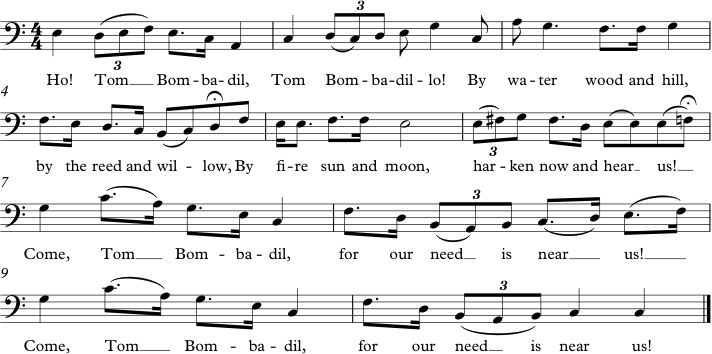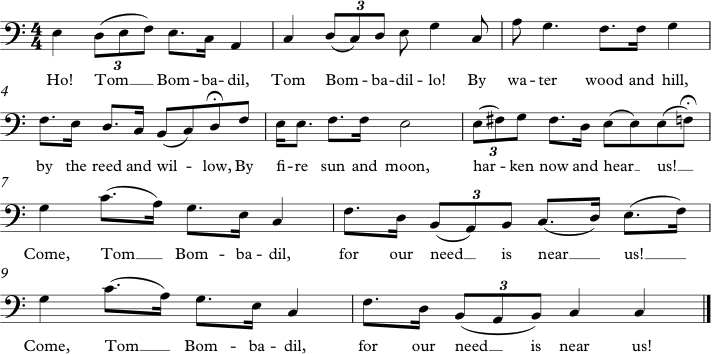Tolkien Ensemble, Tom Bombadil’s Song (I), TE CD 1, Track 10, 5:41.
Tolkien Ensemble, Ho! Tom Bombadil (I), TE CD 1, Track 14, 0:56.
Tolkien Ensemble, Ho! Tom Bombadil (II), TE CD 1, Track 16, 0:45.
Tolkien Ensemble, Tom Bombadil’s Song (IV), TE CD 1, Track 17, 2:55.
Tolkien Ensemble, Ho! Tom Bombadil (I), TE CD 1, Track 14, 0:56.
Tolkien Ensemble, Ho! Tom Bombadil (II), TE CD 1, Track 16, 0:45.
Tolkien Ensemble, Tom Bombadil’s Song (IV), TE CD 1, Track 17, 2:55.
Tom Bombadil, who was cut from the motion picture, is one of the most musical characters of the book. Additionally, he is also one of the most mysterious characters, too. His wife simply describes him as “the master” and when asked directly, Tom only says that he was the first to dwell in Middle-earth. He even maintains that he was there before Melkor arrived (LotR, 131), but it is likely that he just said this to make clear that he has been there for a very long time, since Melkor clearly was the first being to enter the physical world. There are many speculations about the nature of Tom Bombadil, the most daring one being that he is Ilúvatar himself. Regardless of his nature, he certainly is very powerful and uses music as a means to invoke his power. While his music serves as a kind of spell, apparently, he also likes to sing nonsense rhymes as well as songs about himself.
The Hobbits meet him in the Old Forest, when Merry and Pippin are trapped inside the Old Willow-man. He comes nearer, singing a nonsense song, then sings about him bringing his wife some water-lilies. In the book he then frees the trapped Hobbits and leads them to his house, singing along the way, but not always audible to the Hobbits, because he keeps moving away from the Hobbits and coming back a short while later. Before reaching the house, his wife Goldberry sings a stanza, which ends right when the party arrives at the threshold. The Tolkien Ensemble has combined these different parts of Tom’s song into one continuous song, including Goldberry’s stanza, named Tom Bombadil’s Song (I). Stylistically, Tom’s part is very much like the Hobbit folk music we have had a look at earlier: The guitar provides the rhythmic backing together with an accordion, with Tom singing a joyful, upbeat tune. Goldberry’s stanza (2:41) uses the same melody, but is much slower and very ethereal with great use of reverberation. Her part is followed by a solo violin interlude at 3:19, which most likely is to suggest the wonder the Hobbits felt when entering Tom’s house. Goldberry then sings short, textless percussive phrases accompanied by harp, followed by longer sustained passages, both of which have no counterpart in the book. At 5:15, she concludes with the last two lines of her stanza. Tom’s song mainly serves to introduce the Hobbits to him and his wife and home, as well as to give them some rest – and possibly add a moment of comic relief to the story – before sending them on their way again. Frodo’s dream of Gandalf at the top of Orthanc foreshadows the future events and suggests that Frodo’s task will not be finished soon. The wondrous appearance of Tom also adds some credibility to his function as deus ex machina during the Hobbits’ encounter with the Barrow-wights.
This is also where Tom’s music shows supernatural qualities: Tom taught the Hobbits a rhyme to sing when in need of his help. Called Ho! Tom Bombadil (I) on the recording of the Ensemble, the song begins with a short guitar introduction. Tom sings the rhyme (0:10), repeating the last line. In the book the Hobbits repeat the song after Tom, but this is not present on the recording.
transcription (melody): Ho! Tom Bombadil (I), TE CD 1, Track 14.
http://soundcloud.com/middle-earth-music/4-1-9-ho-tom-bombadil/s-o44Re
The second time this rhyme is sung is at the Barrow-downs, when Frodo sings it to call Tom: “In a small desperate voice he began: Ho! Tom Bombadil! and with that name his voice seemed to grow strong: it had a full and lively sound, and the dark chamber echoed as if to drum and trumpet.” (LotR, 142). The rendition of Frodo’s song by the Ensemble Ho! Tom Bombadil (II) has Frodo faintly and clearly mortally afraid singing over a low drone with cymbal effects. The last line fades away into nothingness – very different from the description in the book. In fact, the song leaves the listener wondering whether or not the song did work at all. Tom’s song when answering the call for help, Tom Bombadil’s Song (IV), is identical to his previous song in melody and instrumentation. His actual chant to banish the Barrow-wright employs a more serious tone and is performed over a steady accordion pulse (0:44). Again the Ensemble did not incorporate the descriptions from the book: There is not sign of the ”cry” mentioned in the book, nor do we hear the “long trailing shriek” (LotR, 142) of the Barrow-wright vanishing. Tom’s last stanza (1:42), awaking the Hobbits, again uses the melody and style of Tom Bombadil’s Song.


